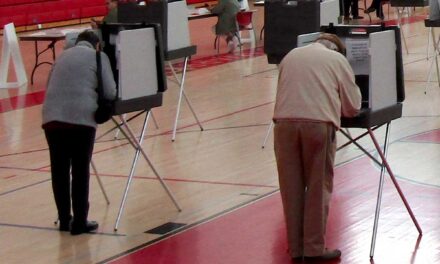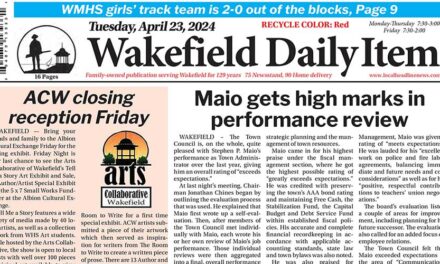Published in the February 19, 2018 edition.
By MARK SARDELLA
WAKEFIELD — The Board of Selectmen spent two hours Friday afternoon discussing whether and how they would comment on last week’s state Energy Facilities Siting Board decision to approve the 8.5-mile, Woburn-to-Wakefield underground transmission line proposed by National Grid and Eversource.
Parties to the decision have until Feb. 22 to submit comments on the EFSB decision if they wish, Town Counsel Thomas Mullen told the board.
Only Selectman Edward Dombroski voiced a strong objection to the EFSB decision, but in the end the board voted to send a carefully worded comment to the Siting Board that reflected a compromise among the selectmen.
Part of the EFSB’s decision addressed the type of cable that would be used along the entire 8.5-mile route. National Grid and Eversource are proposing to use a type called XLPE cable. Some abutters have demanded that a different type of cable be used, one that cancels out electromagnetic fields (EMF) from the cable. They claim possible health impact from those fields, although long-term laboratory experiments have failed to show any disease-causing effects. The EFSB took note of the scientific research on EMF and ruled that the companies can go ahead with the XLPE cable along the entire route.
“The Siting Board finds that magnetic field impacts from construction and operation of the Project using the Primary Route would be minimized,” the decision states.
But Dombroski wanted the selectmen to tell the EFSB that Wakefield wished to join the towns of Stoneham and Winchester in requesting the EMF-canceling, fluid-filled “pipe-type” cable.
He had invited to the meeting a representative from Okonite, the New Jersey company that is the last firm in the world that still manufactures the pipe type cable. Victor Viggiano disputed some of National Grid’s claims that the pipe type cable was far more expensive, would take up more space in the ground and used potentially hazardous fluid within the cable.
After Viggiano’s presentation, Selectman Mehreen Butt objected to the board being subjected to what she called “a sales pitch,” and asked that the board get back to discussing the EFSB decision.
Selectman Ann Santos expressed her skepticism that there was any real health justification for demanding that National Grid use a different type of cable than what had been proposed.
Dombroski maintained that National Grid’s primary objection to going with the EMF-canceling pipe type cable was the higher cost, whereas it was the board’s responsibility to look out for what’s best for the town and its residents.
Selectman Brian Falvey noted that guidelines established by scientific organizations set EMF exposure limits much higher than anything that would be produced by the transmission cable. Furthermore, he suggested that burying the cable would offer some mitigation of magnetic fields.
“I’m not in favor of commenting (to the EFSB) that this cable needs to be changed,” Falvey said.
But Dombroski countered that the town’s hired consultant had acknowledged some epidemiology studies had seen an association between high level exposure to EMF and childhood leukemia.
“If we know that and have an opportunity to reduce EMF,” Dombroski asked, “why wouldn’t we do that?
Falvey responded that decades of study have failed to find the link between EMF and disease. He reiterated his opposition to the board issuing a comment calling for a different cable type.
Selectman Ann Santos agreed with Falvey, noting that only one small epidemiological study in 1979 suggested a link between power lines and cancer. She said that very few residents had contacted her over this issue.
“I’m not seeing a groundswell of concern,” she said.
But Dombroski was unconvinced.
“Why not err on the side of caution if we have an opportunity to mitigate?” he asked.
Selectman Tony Longo said that he wanted Wakefield Municipal Light Department General manager Peter Dion to comment on the alternative new Salem Street route that would bypass a portion of the more densely populated Salem Street.
Dion noted that every time it rains, New Salem Street gets flooded. He expressed concern over having a 345-kV transmission line “sitting underwater.” For that reason, he indicated that Salem Street was the better route.
Falvey pointed out that unlike some of the other towns along the proposed route, Wakefield officials have been working and negotiating with National Grid from the very beginning.
“We got the route we wanted,” he pointed out.
Town Administrator Stephen P. Maio confirmed that. “We tried to make the best deal we could,” he said.
In response to a question from Chairman Paul DiNocco, both Dion and DPW Director Rick Stinson said that they had no objection to the EFSB decision. Stinson added that Wakefield has a four to five-page side agreement with National Grid outlining how certain Wakefield-specific issues will be handled.
Santos asked Dion if he had any concerns about EMF. Dion responded that, “The Light Department does not have a concern with the EMF issue.”
After some further discussion, Falvey proposed a compromise. He moved that the selectmen submit the following comment on the EFSB decision: “We concur with the tentative decision, however if it is possible to implement pipe type cable in Wakefield, that would be preferable.”
Dombroski seconded the motion and it passed unanimously.
After the meeting, Philip Courcy of Pine Hill Circle, a retired National Grid Engineer, said that local boards like the selectmen and state regulators like the EFSB have a responsibility to consider factors that would significantly increase the cost of a project. Using a more expensive type of cable is not just an added cost for National Grid, he said, because that higher cost will be passed on to the local Light Department and ultimately to the ratepayers.




